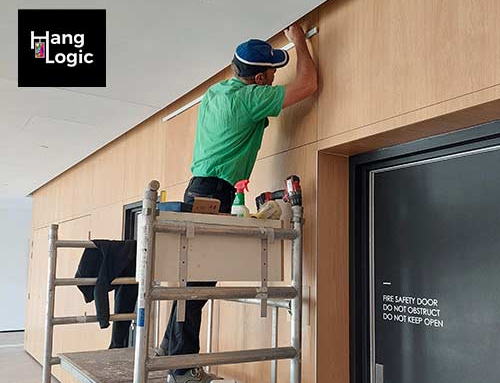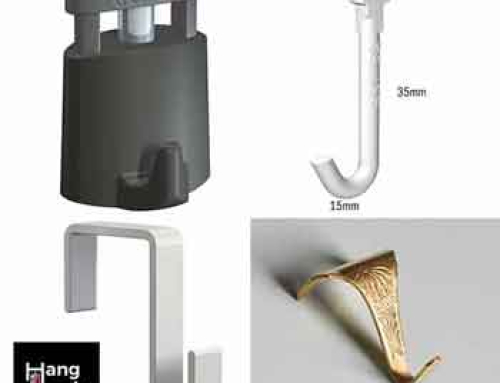
We often get an email or phone call asking us something like:
“I bought this really heavy mirror and I’m not game to hang it, is that something you guys do?”
Or
“We’ve had this immense, heavy picture leaning against our wall for years because my hubby’s too afraid to hang it. Can you help?”
Our answer: “We sure can.”
Indeed, hanging heavy prints can be a challenge. If you get it wrong, your picture could fall down and break. Even worse, your heavy mirror might fall and shatter into pieces (fingers crossed no one was walking by when that happened).
Our tips and tricks will help you understand how to choose the right hanging method, make it look stunning and minimise wall damage.

A Google review
Outstanding service and quality products provided to hang a 15kg mosaic mirror. Additional information was provided to allow DIY installation.
It was a pleasure to explain how to safely hang your beautiful, heavy mirror with the Artiteq Click Rail Pro hanging rail to you. I appreciate that you took the time to give us this feedback Mark.
Step 1. Work Out How Much Your Heavy Picture Weighs.
It just might be lighter or heavier than you think. You can use your bathroom scales.
First, weigh yourself. Then weigh yourself a second time holding the picture. Subtract the 1st from the 2nd and you’ll get the weight of your picture.
Do I hear you asking, “Why not just put the picture on the scale, that would be so much easier.”?
The answer is “No”. Bathroom scales work best in the middle of their range. A few kilograms is too little to weigh accurately.
If your painting, print, picture or mirror weighs less than 3 kg it’s quite light and most hanging solutions should be fine.
If it weighs more than 3 kg and you have Gyprock walls, you’ll need a wall stud or a hanging rail.

Step 2. Determine What Your Walls Are Made Of

Are your walls Gyprock, stone, brick, concrete, timber, plaster or a combination of a few of these?
Most modern interior walls are built using a timber or metal structure with some type of covering. Most of the time the covering is drywall which is the same as Gyprock.
In older homes, brick or stone walls are often plastered (covered with plaster).
Step 3. Heavy Picture: Choose Your Hanging Method
Base your choice of hanging method on your wall composition and the picture or mirror weight.
I’ll admit, I’m biased. My choice will always be a picture hanging system for any type of wall. It’s very versatile:
The Click Rail Pro hanging rail supports up to 50 kg per linear metre.
You can install it on any type of wall surface.
You can adjust the position and height of your artworks as often as you like.
It doesn’t wreck your walls as nails and screws do.
When you don’t want the picture on that wall anymore you’re not left with an unsightly hole from your hook, nail or screw that you need to patch up and repaint (urggh!)
Hanging Heavy Pictures on Gyprock Walls

About three times a year we’re asked: what is the difference between Gyprock, plasterboard, drywall and gypsum board? Short answer- it’s all pretty much the same.
Some interesting history: for thousands of years plaster was made from lime, sand, and animal hair. That’s even how the Egyptians did it in their tombs. Then they decorated the plaster walls with colourful murals. Up to the 1940s, most Australian homes had timber nailed across the house frames, which builders then covered in plaster for a smooth finish.
In 1947, a new process was introduced to Australia: a layer of gypsum-based plaster was set between layers of felt paper to create sheets of board. They provided a smooth finish for painting and were fast and easy to put up. The plaster was already dry between the layers of paper, which is why it is also called Drywall.
The gypsum-based plasters had a faster drying time than the lime-based plaster when manufacturing the plasterboards and this inspired the term ’Gyprock’.
Gyprock sheets have different thicknesses. The standard size for internal walls is 9.5 mm and 12.5 mm. Builders often install thicker Gyprock sheets called Fyrchek (13 and 16mm thick) on interior walls that are outside facing walls to increase fire resistance.
Gyprock is brittle and the thinner it is the less weight it can hold. If you just use a nail for hanging a heavy object in 9.5mm Gyprock, it won’t be strong enough to hold it for long.
You have 3 options:
- Find a stud,
- Use a wall anchor or
- Install a picture hanging system.
People often use Velcro hanging strips and adhesive hooks to hang art, but they are not suited for hanging heavy frames and are unfortunately single-use only.
1. Find a stud

You can use a stud finder to locate it. If you don’t have a stud finder pretend you are that using echolocation to find a fruit tree. Simply knock your knuckles along the wall.
Until you arrive at a stud you’ll hear a hollow sound. When you reach the stud the sound will turn into a dud. Then you can use a thin nail to hold up a picture weighing up to around 3 kg. If it’s heavier, use a course threaded timber screw.
2. Use a Wall Anchor
If you can’t access a stud you can use drywall anchors. The anchor gives your screw extra stability. There are plastic and metal anchors. For up to 5 kg plastic is okay, beyond that use a metal anchor. When you drill into them, 2 small legs expand and support the screw on the other side of the plasterboard.
3. Best of All: Install a Picture Hanging System

A picture hanging system consists of a hanging rail with hanging wires and hooks. You attach the hanging rail to the wall by means of little plastic clips (called ‘click and connects‘) which the rail clicks onto. The hanging wires are inserted into the rail and can slide to the left and right. That’s why you can hang your pictures anywhere along the walls.
The hooks slide up and down the hanger and are inserted into the d-rings or wire on the back of the picture. That’s why you can hang your pictures any height.
On 9.5 mm and 12.5 mm Gyprock walls, when hanging heavy pictures, best to install the click and connect clips onto which the hanging rail is clipped with special plastic plugs for plaster walls called Wallmates. For thicker Fyrchek walls easiest to use the metal Wallmates. Use 45mm long screws.

Hanging Pictures on Brick Walls

Many customers want to maintain the natural beauty of their brick walls which can be challenging when it comes to hanging an heavy picture or mirror. Why? Because it’s nearly impossible to fill, patch, or repair nail hole damage once it has occurred. Over time, you’ll end up with the Swiss Cheese effect, just like the photo to your left.
Wondering why there is so much damage in that one area (almost 20 holes)? This is because optimal viewing is at eye height; you want to have the centre of the painting about 1.5 to 1.7 m up from the floor. So most wall damage is it about 1.8 m 22 m above the floor because this is where the screw or nail is positioned behind the picture. This damage isn’t only ugly, it can endanger the integrity of your wall,; in historic buildings most walls are load-bearing. It also makes it difficult to find a new spot to place a new heavy picture.
The easy solution: never drill holes, drive screws or hammer nails into brick or masonry walls. Especially if you are planning to hang heavy pictures!
This is where the wall-attached hanging systems come in handy. You may know them by other names such as gallery systems, art rails, picture rails, art tracking, picture tracks etc.
They all consist of an art track that is mounted high on the wall or ceiling.
Perlon/nylon hangers or stainless-steel cables hang down from them.
A hook that slides up and down is attached to the object you want to hang.

Hanging Heavy Pictures on Concrete Walls

Concrete walls are often found in schools and institutions, some homes have them as feature walls. Take a look at the concrete brick display wall in a church community centre.
They are extremely durable and quite economical. Educational and municipal organisations frequently change their displays which means lots of damage.
Installing a hanging system would be best the best solution to install heavy pictures or mirrors. Then displays can be quickly installed and the hardware is reusable, which is great for the budget.

In the photo to your right, the Artiteq Click Rail art track runs the entire length of this concrete masonry wall – also above windows and doors – which looks best.
The fine adjustments required to make the above row and column hang so precise can be easily done with the Artiteq hanging system.
It would be a frustrating nightmare and take ages to achieve this look with screws or nails. Getting all the artwork to hang at the same level requires lots of measuring and even if you get all the measurements right you’re not guaranteed a perfect result, even when hanging very heavy pictures.
Why? Because the d-rings or the wires/strings at the back of the pictures also need to be at exactly the same height. A couple of millimetres out (aka human error) and you’ll be using your drill to create another hole for your screw & patching up the old, wrong hole.

Hanging Pictures on Stone Walls

We recently received this enquiry:
“We have a stone (drystack veneer) fireplace wall in our living room and I’d very much like to add a piece of art to it. The artwork is painted on wood so it’s a really heavy picture. I know people mount objects to stone all the time, so I’m hoping you guys can recommend a product made for this, I’m hoping you’ve got a downright good idea.”
Stone walls are so beautiful and your author (me) thinks it’s a sin to destroy them with ugly screw holes.
It’s definitely best to use an art hanging system for any heavy picture, photograph or mirror you want to hang on your stone wall, irrespective of its weight.

Time for an upgrade?
Are you looking to know more about how can you improve the beauty and efficiency of your rental property?
Whether you are looking for something simple to keep your walls tidy and pristine or comprehensive systems to create an impressive art display, we are just a phone call away.
Contact us today by calling us on 0432 924 305 or email us at [email protected] for a FREE consultation. Or, if you prefer to work things out yourself, sift through our frequently asked questions.






